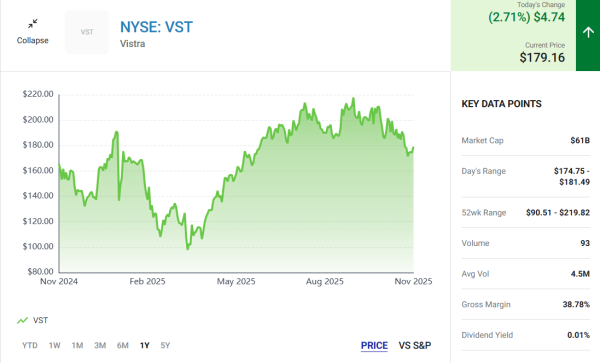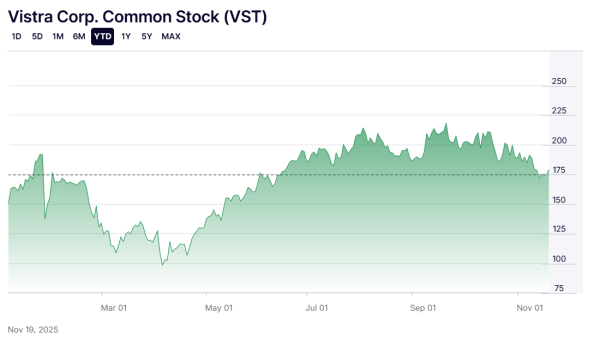The recent pullback in Vistra Energy has captured the attention of brokers at LFtrade, who note that the stock’s decline below 190 comes at a time when markets are cooling from an exceptional rally. After months of strong performance across major indices, investor sentiment has shifted as expectations surrounding artificial intelligence expansion and energy demand adjust.
Against this backdrop, Vistra, a major U.S. electricity provider, has fallen 18% from its peak. Brokers from the company are evaluating whether this dip represents a short-term correction or a meaningful long-term opportunity for investors seeking durable energy exposure.

A Leading Provider Positioned for Rising U.S. Energy Needs
Vistra Energy stands as one of the most significant competitive energy providers in the United States. The company supplies electricity to over 5 million customers, spanning residential, commercial, and industrial sectors. Its extensive fleet of assets gives Vistra a presence in many of the country’s major competitive wholesale markets.
Unlike traditional utilities that rely heavily on long-term power purchase contracts, Vistra operates primarily as a merchant power company, selling electricity directly into competitive wholesale markets across 18 states and Washington, D.C. This short-term market exposure allows the company to benefit from rising wholesale power prices, especially in regions where supply remains constrained and demand continues to increase.
Vistra also integrates its retail business with its generation fleet and uses derivatives to hedge commodity risks. This structure helps reduce exposure to sudden price changes and contributes to more stable cash flow, even in an environment where natural gas and electricity prices can shift rapidly.
Capacity Expansion Strengthens Its Long-Term Outlook
Growth remains a central part of Vistra’s strategy. Recently, the company acquired seven modern natural gas generation facilities from Lotus Infrastructure Partners, adding approximately 2,600 MW of capacity. This acquisition broadens its reach in the Midwest, Northeast and California, strengthening its position in areas where grid reliability and energy demand are emerging concerns.
In addition to acquisitions, Vistra is expanding through new development. The company is building two advanced natural gas units totaling 860 MW at its Permian Basin Power Plant.
With the region’s energy-intensive oil and natural gas industries increasingly electrifying their operations, power demand in West Texas is rising. The expansion will increase the plant’s capacity from 325 MW to 1,185 MW by 2028, giving Vistra the ability to serve one of the fastest-growing industrial hubs in the country.
Merchant Power Exposure Brings Both Opportunity and Risk
While Vistra’s merchant model allows it to capture gains during periods of elevated power prices, it also makes the business more vulnerable to wholesale price volatility. Supply and demand imbalances in the day-ahead and spot markets can cause significant swings in revenue and operating cash flow.
However, current market conditions are generally favorable. Several of Vistra’s key markets, particularly PJM, continue to face tight supply conditions that support higher pricing. A slow pace of new power plant construction, regulatory delays, and the retirement of older coal and nuclear assets have created structural challenges in the industry.
Additionally, supply chain issues and labor shortages have increased lead times for equipment and maintenance, hindering the ability to quickly bring the new generation online. These pressures have resulted in a tight supply-demand balance, which benefits merchant generators like Vistra, especially during peak load periods when pricing tends to rise.
Industry Tailwinds Driven by Data Center Expansion
According to TD Cowen analyst, the energy sector is experiencing a once-in-a-generation opportunity as demand accelerates. The rapid expansion of hyperscale data centers, powered by the growth of artificial intelligence, requires immense amounts of electricity. Vistra is well-positioned to support this expansion, with its broad competitive generation footprint and ability to scale capacity.
The stock currently trades at a premium compared with traditional utility companies due to its growth prospects. After trading as high as 28 times projected 2024 earnings, Vistra now trades at 22.8 times earnings and approximately 18.2 times projected 2026 earnings, reflecting moderation after substantial investor enthusiasm earlier this year.

Is Now the Right Time to Buy?
Despite short-term uncertainty in the broader market, Vistra’s long-term investment case remains compelling. The company is strategically positioned to meet rising electricity needs across the United States, particularly within high-growth data center corridors. Its merchant power structure allows it to capitalize on higher market prices, while recent acquisitions and ongoing expansion projects provide meaningful capacity growth.
With the stock now trading below 190 after an 18% decline from recent highs, the pullback may offer an appealing entry point for investors who believe in the long-term structural demand powering the U.S. energy sector.







